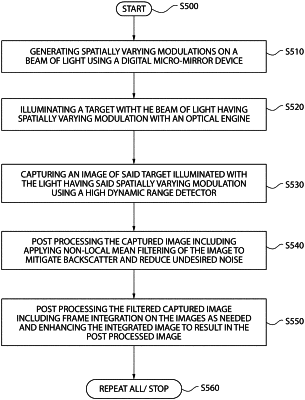| CPC H04N 23/74 (2023.01) [G06T 5/002 (2013.01); G06T 5/20 (2013.01); G06T 5/50 (2013.01); G06T 2207/10152 (2013.01)] | 8 Claims |

|
1. A method for imaging underwater objects in a degraded underwater visual environment having turbid or turbulent medium for close range target inspection, diver assist, and/or robotic operations, said method comprising:
a) generating, via a light source comprising an optical engine configured with a spatial light modulator, spatially varying modulation on a beam of light using the spatial light modulator to generate a plurality of coded modulation patterns having different lighting conditions corresponding to the plurality of coded modulation patterns to project onto and illuminate a target in the degraded underwater visual environment at, at least, a CMOS or SCMOS camera associated frame rate, wherein the sequence of coded illumination patterns follow a Bernoulli random variable distribution, wherein each of the different lighting conditions corresponds to one of a sequence of coded illumination patterns associated with the plurality of coded modulation patterns, and wherein the plurality of coded modulation patterns each has a repeating pre-defined geometric configuration;
b) illuminating, via the light source, the target with the beam of light having the spatially varying modulation using the sequence of coded illumination patterns;
c) capturing, via a detector comprising a CMOS or SCMOS camera, a plurality of images of said target illuminated with said beam of light having said spatially varying modulation through the sequence of coded illumination patterns, wherein the detector is configured to capture the plurality of images at the CMOS or SCMOS associated frame rate; and
d) post processing, via the detector or via a remote computing device, the plurality of captured images by applying a non-local means filtering operator configured to jointly operate on all portions of each of the plurality of captured images while grouping similar block elements having the repeating pre-defined geometric configuration to mitigate backscatter from the degraded underwater visual environment, wherein the post processing further includes, after applying the non-local means filter operator: i) performing frame integration on the plurality of captured images to generate an integrated frame, and ii) enhancing the integrated frame by applying a total variation noise reduction filter to the integrated frame to mitigate backscatter, reduce noise, and/or improve pattern contrast.
|